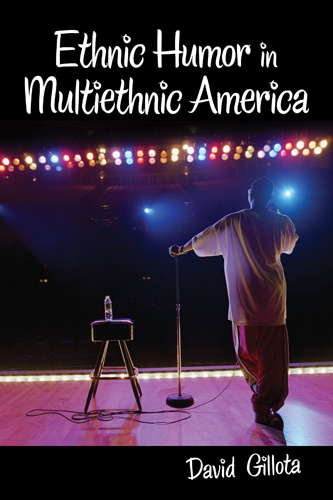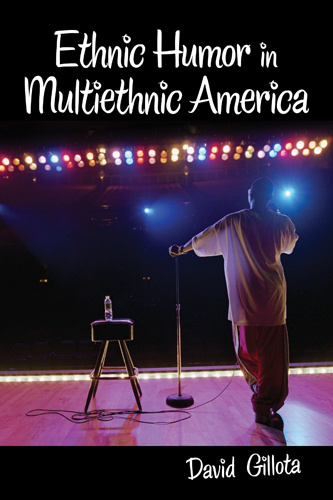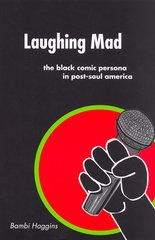Our shopping cart is currently down. To place an order, please contact our distributor, UTP Distribution, directly at utpbooks@utpress.utoronto.ca.
When wielded by the white majority, ethnic humor can be used to ridicule and demean marginalized groups. In the hands of ethnic minorities themselves, ethnic humor can work as a site of community building and resistance. In nearly all cases, however, ethnic humor can serve as a window through which to examine the complexities of American race relations. In Ethnic Humor in Multiethnic America, David Gillota explores the ways in which contemporary comic works both reflect and participate in national conversations about race and ethnicity.
Gillota investigates the manner in which various humorists respond to multiculturalism and the increasing diversity of the American population. Rather than looking at one or two ethnic groups at a time—as is common scholarly practice—the book focuses on the interplay between humorists from different ethnic communities. While some comic texts project a fantasy world in which diverse ethnic characters coexist in a rarely disputed harmony, others genuinely engage with the complexities and contradictions of multiethnic America.
The first chapter focuses on African American comedy with a discussion of such humorists as Paul Mooney and Chris Rock, who tend to reinforce a black/white vision of American race relations. This approach is contrasted to the comedy of Dave Chappelle, who looks beyond black and white and uses his humor to place blackness within a much wider multiethnic context.
Chapter 2 concentrates primarily on the Jewish humorists Sarah Silverman, Larry David, and Sacha Baron Cohen—three artists who use their personas to explore the peculiar position of contemporary Jews who exist in a middle space between white and other.
In chapter 3, Gillota discusses different humorous constructions of whiteness, from a detailed analysis of South Park to “Blue Collar Comedy” and the blog Stuff White People Like.
Chapter 4 is focused on the manner in which animated children’s film and the network situation comedy often project simplified and harmonious visions of diversity. In contrast, chapter 5 considers how many recent works, such as Harold and Kumar Go to White Castle and the Showtime series Weeds, engage with diversity in more complex and productive ways.
Gillota investigates the manner in which various humorists respond to multiculturalism and the increasing diversity of the American population. Rather than looking at one or two ethnic groups at a time—as is common scholarly practice—the book focuses on the interplay between humorists from different ethnic communities. While some comic texts project a fantasy world in which diverse ethnic characters coexist in a rarely disputed harmony, others genuinely engage with the complexities and contradictions of multiethnic America.
The first chapter focuses on African American comedy with a discussion of such humorists as Paul Mooney and Chris Rock, who tend to reinforce a black/white vision of American race relations. This approach is contrasted to the comedy of Dave Chappelle, who looks beyond black and white and uses his humor to place blackness within a much wider multiethnic context.
Chapter 2 concentrates primarily on the Jewish humorists Sarah Silverman, Larry David, and Sacha Baron Cohen—three artists who use their personas to explore the peculiar position of contemporary Jews who exist in a middle space between white and other.
In chapter 3, Gillota discusses different humorous constructions of whiteness, from a detailed analysis of South Park to “Blue Collar Comedy” and the blog Stuff White People Like.
Chapter 4 is focused on the manner in which animated children’s film and the network situation comedy often project simplified and harmonious visions of diversity. In contrast, chapter 5 considers how many recent works, such as Harold and Kumar Go to White Castle and the Showtime series Weeds, engage with diversity in more complex and productive ways.
A valuable addition to the field, Ethnic Humor in Multiethnic America makes a fresh and compelling argument with fascinating readings of many performers and comic routines in stand-up, film, and television.
A fascinating comparative study of contemporary ethnic humor in popular culture, illuminating the truth that ethnic groups are made and unmade not in isolation, but in dynamic relation to each other.
Using comic performance—stand-up, situation comedy, animated television series, and children's films—Gillota looks at the impact of diversity on humor. Recommended.
Gillota’s work is an important contribution to a growing body of scholarship on the serious business of comedy. His work makes a strong case as to why it is necessary to analyze a particular society’s humor if one seeks to understand its values and the ways in which its history continues to shape its culture today.
DAVID GILLOTA is a lecturer in the humanities and ethnic studies departments at the University of Wisconsin–Platteville. He has published essays on American humor in Journal of Popular Film and Television and the Journal of Popular Culture.
Acknowledgments
Introduction: The Boundaries of American Ethnic Humor
1. "Just Us": African American Humor in Multiethnic America
2. The New Jewish Blackface: Ethnic Anxiety in Contemporary Jewish Humor
3. "Cracker, Please!": Toward a White Ethnic Humor
4. Imagining Diversity: Corporate Multiculturalism in the Children's Film and the Situation Comedy
5. Comedy with Borders?: Toward a Multiethnic Humor
Notes
Index
Introduction: The Boundaries of American Ethnic Humor
1. "Just Us": African American Humor in Multiethnic America
2. The New Jewish Blackface: Ethnic Anxiety in Contemporary Jewish Humor
3. "Cracker, Please!": Toward a White Ethnic Humor
4. Imagining Diversity: Corporate Multiculturalism in the Children's Film and the Situation Comedy
5. Comedy with Borders?: Toward a Multiethnic Humor
Notes
Index






